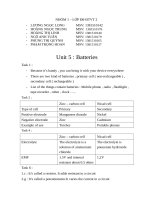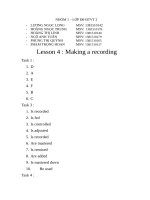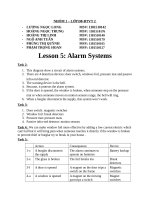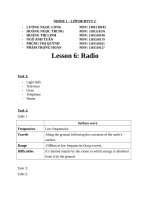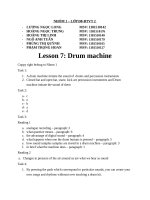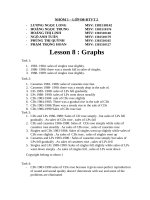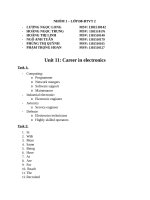ĐIỆN tử VIỄN THÔNG DTVT2 nhom10 bai4 txt khotailieu
Bạn đang xem bản rút gọn của tài liệu. Xem và tải ngay bản đầy đủ của tài liệu tại đây (57.37 KB, 5 trang )
Making A Recording
D8-DTVT2
Group 10 :
Nguyễn Văn Hướng
Hà Tuấn Linh
Nguyễn Đức Thương
Nông Văn Quân
Trần Văn Quân
Vũ Văn Tu
Hà Đình Thanh Tâm
Task 1: Tuning–in
Study this diagram. It shows the stages in marking a recording. Try
with your to match the short texts which follow to each stage.
Compare your answers with your partner.
1-d) The musicians play in a recording studio. Each voice and instrument is
recorded using different microphones.
2-a) Each microphone input in mixed on a mixer. In a commercial recording studio
this is done by a sound engineer.
3-e) The instruments are channelled through the mixer into a multitrack tape
recorder.
4-b) The sounds on the multitrack are remixed until the musicians are happy with
the sounds.
5-f) During this process, effects, such as reverb are used to shape the sound.
6-c) The output is recorder on a two-track mastering machine. The product is a
master tape with two stereo channels.
The musicians play in a recording studio. Each voice and instrument is
recorded using different microphones. Each microphone input in mixed on a
mixer. In a commercial recording studio this is done by a sound engineer. The
instruments are channelled through the mixer into a multitrack tape
recorder. The sounds on the multitrack are remixed until the musicians are
happy with the sounds. During this process, effects, such as reverb are used to
shape the sound. The output is recorder on a two-track mastering machine.
The product is a master tape with two stereo channels.
Task 2: Read this text to check your answers
MAKING A RECORDING
For professional recording, the process begins in the studio. Each vocalist,
instrument, or group of instruments is linked to a microphone on a mixer or mixing
desk.
The mixing desk allows the studio engineer to a track on adjust the recording
level for each channel. This is shown by a VU meter or a paragraph where the
indicator is a sequence of lights. Too low a level results in background hiss; too
high a level causes distortion. The mixer also has EQ (equalization) controls which
adjust bass and treble.
The output form each channel is fed to a track on a multitrack tape recorder. After
the music has been recorded on the multitrack, it is mastered down. This means
that it is fed back through the mixer to adjust the levels of vocalist and instruments
in relation to each other. At this time, effects can be used to alter the sound. One of
the most common is reverb (reverberation) which can made the music sound as if it
was recorded in a very large building or a very small room.
The edited sound is recorded on a two-track mastering machine to produce a
master tape. The master is then used to make records, cassettes, CDs or MDs.
Language studyDescribing a process
In English the passive often used to describe processes . Study these examples:
1 Each instrument is recorded.
2 Speccial effect are used.
3 Copies can be made
The passive is made using the verb to be (be, is, are, ect) and the past participle of
the verb. Most technical verbs are regular so the past participle is made simply by
adding –ed ( Example 1) . Watch the spelling of the past participle of verbs like
control (controlled ) and use ( Example 2). The passive infinitive is used in the
same place as ordinary infinitives, for the example after verbs like must and can
( Example 3)
Task 3: Complete this summary of how to make a recording, by
putting each of the verbs in brackets in the correct form.
Each instrument is recorded using a microphone. The sound are fed to a mixing
desk. The recording level are controlled and the EQ is adjusted by the sound
engineer. The output is recorded on a multitrack. The sounds from the multitrack
are mastered back through the mixer. The tape is remixed until the musicians are
happy with the sound. Special effects can be added on the mixing desk.
Theremixed tape is mastered down to produce a master tape. This can be used to
produce copies in many different formats.
Task 4: Listen.
Task 5: Word study
One way of remembering new word is to group them into topic sets
according to their area of meaning. The words in Task 5 are all
concerned with making a recording. They fall in to three topic sets:
people, olace, and equipment. Make your own topic sets for other
units in this book.
Place
Studio
People
Musician
Sound enginner
Vocalist
Equipment
Master tape
Microphone
Multitrack recorded
Mixer
Task 6: Writing Describing a process
There are many stages involved in the production of CD discs. The
more important ones are shown in fig.1. You can describe the whole
process of CD production:
Fistly, a blank perspex disc is grinded and poslished to optical flatness. Next, it is
washed and spin-dried. It is then coated with a thin layer of photoresist and cured
in an oven. After that, as the disc is revolved, a laser beam is used to mark audio
information pattern on its surface. This process is known as ‘cutting’ disc. The
photoresist is then developed and etched to produce pits in the disc’s surface.
These pits represent the digital audio pattern.
The disc is then given a thin silver coat to make it electrically conductive. Next, the
electroplanting is used to make a series of positive and negative copies of the
master disc. The final negative copy is used to make a large number of indentical
CDs. The surface of CD containing the pits marks is then coated with a 10 mm
layer of aluminium, followed by a protective layer of plastic. Afterpunching the
centre hole,a label is applied and the CD is packaged

